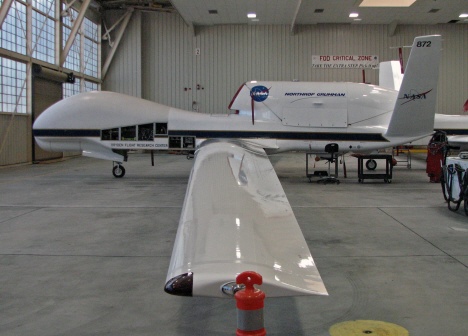From Paul Newman, GloPac co-project scientist:
We were planning a test flight of the Global Hawk for Wednesday (March 10), but unfortunately the wind speeds are forecast to be too strong (with gusts greater than 40 mph). You can get a feel for the problem of high winds by driving your car at 40 mph and then sticking your hand out the window. But why exactly are strong winds a problem for a plane?

The Global Hawk has a 116- foot wingspan. (For comparison, the Boeing 737-800 commercial airliner has a 113-foot wingspan). This long wing allows the Global Hawk to soar to 65,000 feet. However, like the booby bird, the Global Hawk is graceful in the air but awkward on the ground. With a heavy fuel load in the wings, a strong wind can easily tilt the wing into the ground and damage the plane. So we’ll play it carefully and wait for another day.




The old U2’s had little wheels on the wings to keep them from flapping. Have you tried that?
The asthenosphere at the polar sites: Will the craft be flown there to discover the make-up of the bright circular clouds visible when that polar location is in its winter moments? If so, then it is conceivable that protons from the 2003 solar CME would be the main cloud forming particles. As to there being any interest in those particles, they are a positive energy, and when they interact with objects, then EM and magnetics are created. So, would such as that create problems for the craft?
Concern from an armchair solar physicist. Eddie R.
@Howard Kellogg. NASA has two ER-2 aircraft (the civilian version of the U-2). The ER-2 has a bicycle gear (a main wheel and a small tail dragger wheel). The “outrigger” wheels are called pogos. Those pogos fall away from the aircraft as the ER-2 takes off, and the crew collects them off the runway. The pilots have to balance the aircraft on landing like tight-rope walkers. The Global Hawk has a tricycle gear that makes them a bit more stable than the ER-2, but long-winged aircraft are still difficult to handle in stiff winds.
I’m not sure if the Northrop Grumman team has explored outrigger wheels for heavy wind conditions. However, 9 out of 10 days the winds are within limits, so we’re hoping that the weather will be kind to us.
@Ed McCarvill. The asthenosphere is part of the Earth’s crust. I think you’re referring to the stratosphere and the polar stratospheric clouds or PSCs that form in mid-winter. PSCs are very beautiful and cool (so to speak) clouds. They form at temperatures of about -109 Fahrenheit!!! Unfortunately, the Arctic stratosphere is already transitioning to the warmer conditions of summer, and the temperatures are now too warm for PSCs to form. If you’d like to see some pictures of PSCs, go to: http://acdb-ext.gsfc.nasa.gov/People/Newman/solveii/pics/newman_pics/flt_030114/images.html
Wow, Paul your Global Hawk looks awesome I wish you all the best with your test flight and hope the weather is calm when you fly. Good Luck